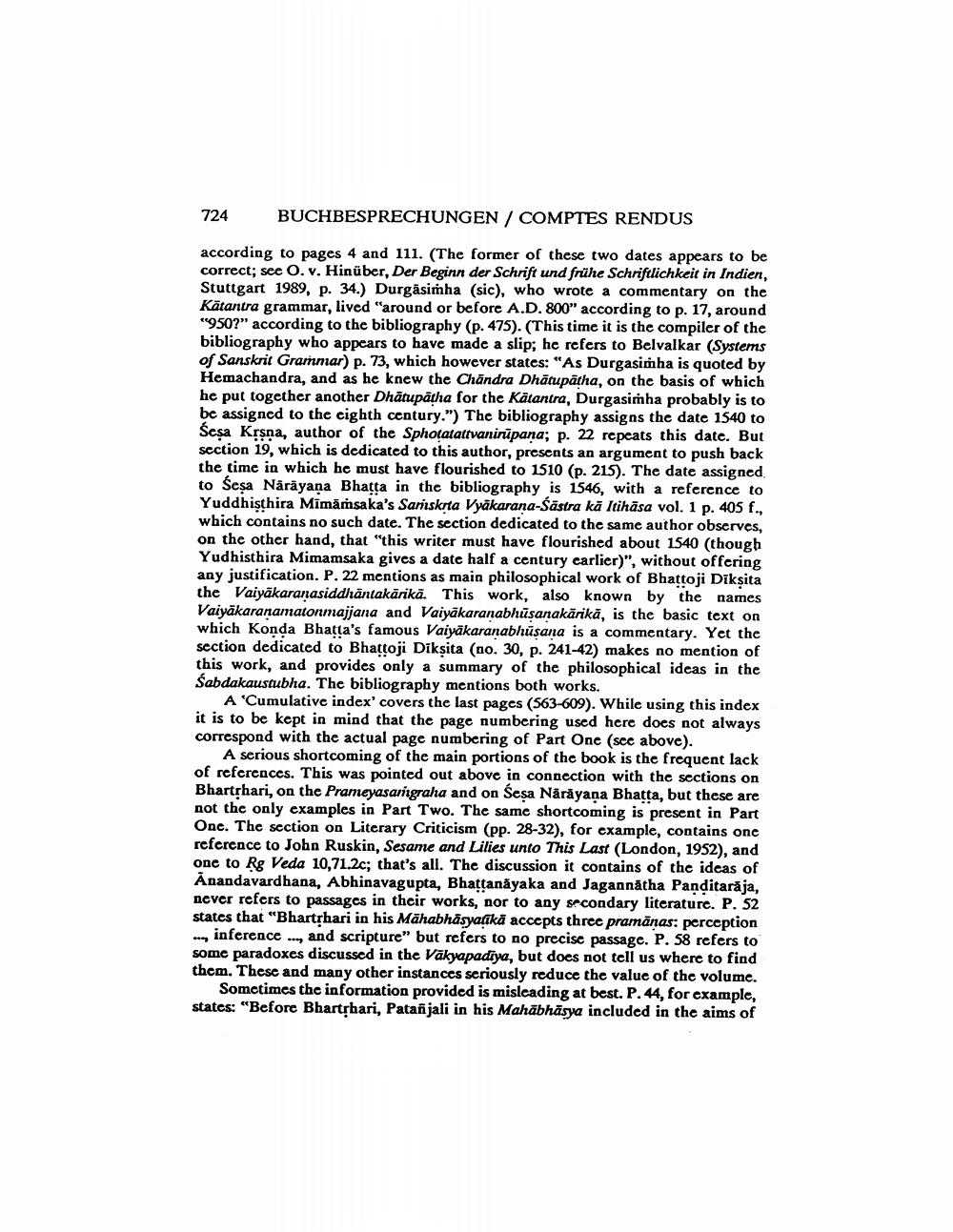Book Title: Book Review Encyclopedia Of Indian Philosophies Author(s): Johannes Bronkhorst Publisher: Johannes Bronkhorst View full book textPage 7
________________ 724 BUCHBESPRECHUNGEN / COMPTES RENDUS according to pages 4 and 111. (The former of these two dates appears to be correct; sec O. v. Hinüber, Der Beginn der Schrift und frühe Schriftlichkeit in Indien, Stuttgart 1989, p. 34.) Durgāsimha (sic), who wrote a commentary on the Kätantra grammar, lived "around or before A.D. 800" according to p. 17, around "950?" according to the bibliography (p. 475). (This time it is the compiler of the bibliography who appears to have made a slip; he refers to Belvalkar (Systems of Sanskrit Grammar) p. 73, which however states: "As Durgasimha is quoted by Hemachandra, and as he knew the Chandra Dhātupātha, on the basis of which he put together another Dhātupatha for the Kätantra, Durgasimha probably is to be assigned to the cighth century.") The bibliography assigns the date 1540 to Ścsa Krsna, author of the Sphotatattvaninūpana; p. 22 repeats this date. But section 19, which is dedicated to this author, presents an argument to push back the time in which he must have flourished to 1510 (p. 215). The date assigned to sesa Nārāyana Bhatta in the bibliography is 1546, with a reference to Yuddhisthira Mimāmsaka's Sanskrta Vyakarana-Šāstra kā Itihāsa vol. 1 p. 405 f., which contains no such date. The section dedicated to the same author observes, on the other hand, that "this writer must have flourished about 1540 (though Yudhisthira Mimamsaka gives a date half a century carlier)", without offering any justification. P. 22 mentions as main philosophical work of Bhattoji Diksita the Vaiyakaranasiddhantakārikā. This work, also known by the names Vaiyakaranamatonmajjana and Vaiyakaranabhūsanakārikā, is the basic text on which Konda Bhatta's famous Vaiyākaranabhūsana is a commentary. Yet the section dedicated to Bhattoji Diksita (ao. 30, p. 241-42) makes no mention of this work, and provides only a summary of the philosophical ideas in the Šabdakaustubha. The bibliography mentions both works. A 'Cumulative index' covers the last pages (563-609). While using this index it is to be kept in mind that the page numbering used here does not always correspond with the actual page numbering of Part One (see above). A serious shortcoming of the main portions of the book is the frequent lack of references. This was pointed out above in connection with the sections on Bhartshari, on the Prameyasangraha and on Sesa Nārāyana Bhatta, but these are not the only examples in Part Two. The same shortcoming is present in Part One. The section on Literary Criticism (pp. 28-32), for example, contains one reference to John Ruskin, Sesame and Lilies unto This Last (London, 1952), and one to Rg Veda 10,71.2c; that's all. The discussion it contains of the ideas of Anandavardhana, Abhinavagupta, Bhattanayaka and Jagannatha Panditarăja, never refers to passages in their works, nor to any secondary literature. P. 52 states that "Bharthari in his Māhabhäsyafikā accepts three pramänas: perception --, inference ... and scripture" but refers to no precise passage. P. 58 refers to some paradoxes discussed in the Vākyapadiya, but does not tell us where to find them. These and many other instances seriously reduce the value of the volume. Sometimes the information provided is misleading at best. P. 44, for example, states: "Before Bharthari, Patanjali in his Mahābhāsya included in the aims ofPage Navigation
1 ... 5 6 7 8
